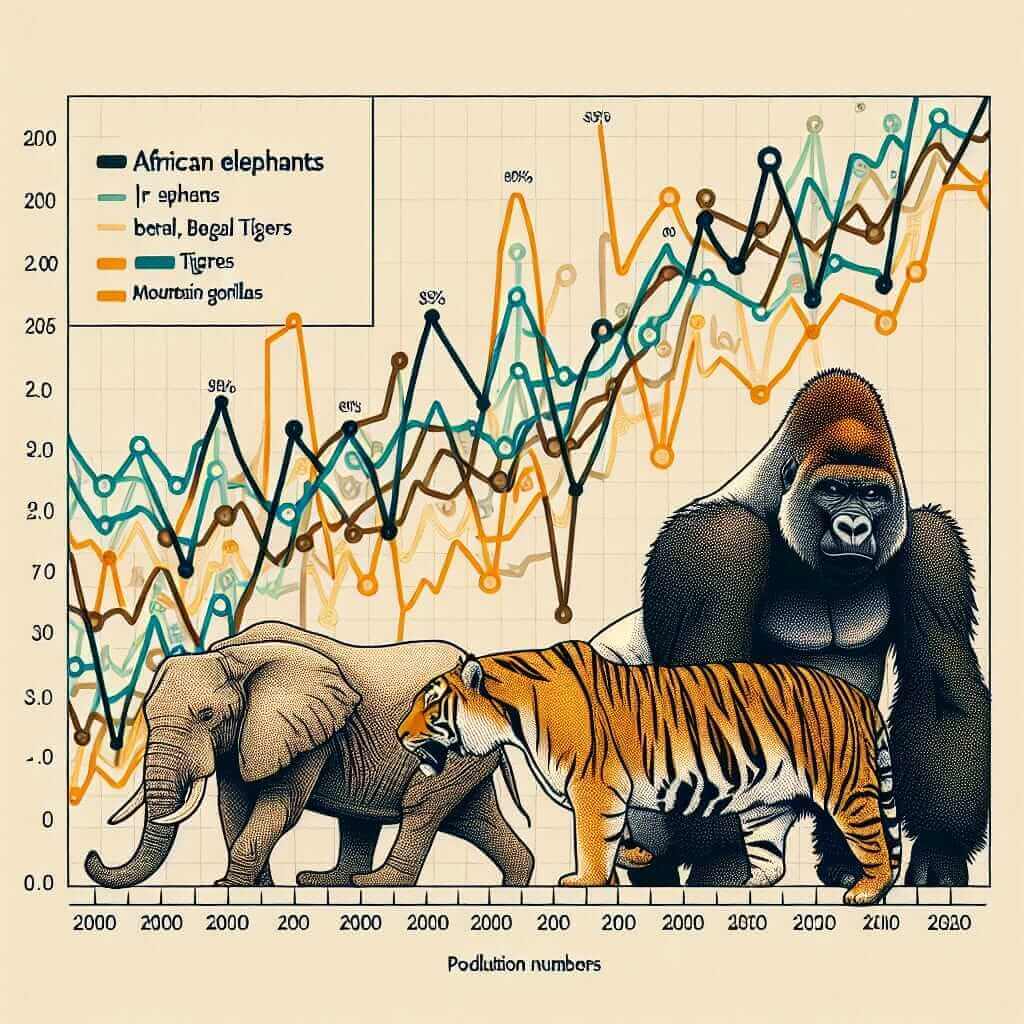The keyword “Wildlife Population Changes (2000-2023)” presents a compelling opportunity for IELTS Writing Task 1 preparation. This topic frequently appears in the IELTS exam, requiring test-takers to analyze and report on data related to wildlife populations over a specific timeframe.
To excel in this area, it’s crucial to familiarize yourself with common variations of the keyword and related user queries, including:
- Trends in Global Wildlife Populations
- Factors Affecting Wildlife Numbers
- Impact of Human Activities on Wildlife
- Conservation Efforts and Their Effectiveness
Sample IELTS Writing Task 1 Question
You should spend about 20 minutes on this task.
The chart below shows changes in the global population of three animal species between 2000 and 2020.
Summarise the information by selecting and reporting the main features, and make comparisons where relevant.
Write at least 150 words.

Data Analysis
The table illustrates the population fluctuations of African elephants, Bengal tigers, and mountain gorillas over two decades. Notably, African elephants experienced a consistent decline, plummeting from 600,000 in 2000 to 400,000 in 2020. Bengal tigers also witnessed a downward trend, albeit with a slight increase from 2015 to 2020. Conversely, mountain gorillas exhibited a steady growth in population throughout the period.
Model Answer
The provided table presents a clear picture of how the global populations of African elephants, Bengal tigers, and mountain gorillas have changed between the years 2000 and 2020.
Over the two decades, African elephants saw a dramatic decline in their numbers, dropping from 600,000 to 400,000. This represents a significant decrease of over 30% in their population. Similarly, Bengal tigers experienced a downward trend, with their numbers falling from 4,500 to 2,900. However, there was a slight increase in their population between 2015 and 2020, providing a glimmer of hope for their conservation.
In contrast to the declining trends of elephants and tigers, mountain gorillas exhibited a positive trend. Their population increased steadily from 700 in 2000 to 1,050 in 2020, demonstrating the success of conservation efforts aimed at protecting this critically endangered species.
To summarize, while African elephants and Bengal tigers faced significant population declines, the mountain gorilla population showed encouraging growth over the period. These trends highlight the urgent need for continued conservation measures to protect endangered species and combat factors contributing to their population decline.
(Word Count: 179 words)
Writing Tips for Wildlife Population Topics
- Vocabulary: Use precise language to describe trends (e.g., “declined steadily,” “fluctuated significantly,” “showed a marked increase”).
- Comparisons: Highlight key similarities and differences between species and their population changes.
- Data Accuracy: Report the data accurately and avoid making unsupported assumptions.
- Conciseness: Be concise in your writing, focusing on the most relevant information.
- Grammar: Use correct grammar and sentence structure to ensure clarity.
Essential Vocabulary
- Decline (verb): To decrease in number or amount. (dɪˈklaɪn)
- Increase (verb): To become greater in number or amount. (ɪnˈkriːs)
- Fluctuate (verb): To rise and fall irregularly in number or amount. (ˈflʌktʃueɪt)
- Trend (noun): A general direction of change over time. (trɛnd)
- Population (noun): The total number of a particular species living in a particular area. (ˌpɒpjuˈleɪʃən)
- Conservation (noun): The protection and management of natural resources, especially species and habitats. (ˌkɒnsəˈveɪʃən)
- Endangered (adjective): Seriously at risk of extinction. (ɪnˈdeɪndʒəd)
- Habitat (noun): The natural home or environment of an animal, plant, or other organism. (ˈhæbɪtæt)
- Species (noun): A group of living organisms consisting of similar individuals capable of exchanging genes or interbreeding. (ˈspiːʃiːz)
- Significant (adjective): Sufficiently great or important to be worthy of attention. (sɪɡˈnɪfɪkənt)
Conclusion
Mastering the art of describing wildlife population changes is essential for achieving a high band score in IELTS Writing Task 1. By understanding data trends, utilizing appropriate vocabulary, and presenting information coherently, you can confidently tackle this question type and demonstrate your writing prowess. Remember to practice analyzing various data representations and familiarize yourself with common wildlife-related terminology to excel in this area.